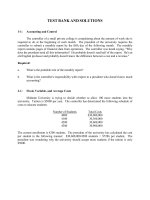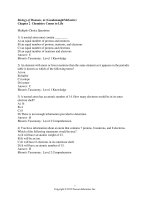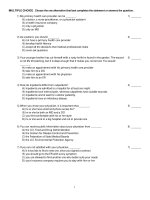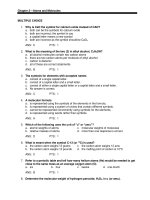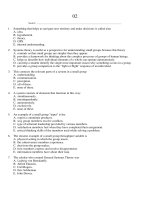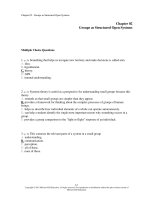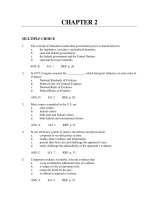Psychological testing principles applications and issues 8th edition kaplan test bank
Bạn đang xem bản rút gọn của tài liệu. Xem và tải ngay bản đầy đủ của tài liệu tại đây (243.72 KB, 12 trang )
Chapter 2—Norms and Basic Statistics for Testing
MULTIPLE CHOICE
1. When you assert that it is improbable that the mean intelligence test score of a particular group is 100,
you are using ____.
a. descriptive statistics
b. scale
c. reliability
d. inferential statistics
ANS: D
PTS: 1
REF: Why We Need Statistics
2. Statistical procedures that summarize and describe a series of observations are called
a. inferential statistics.
b. descriptive statistics.
c. scales.
d. ratios.
ANS: B
PTS: 1
REF: Why We Need Statistics
3. Statistical procedures that allow one to make inferences about large groups by examining a smaller
sample are called
a. populations.
b. descriptive statistics.
c. inferential statistics.
d. ratios.
ANS: C
MSC: www
PTS: 1
REF: Why We Need Statistics
4. Which of the following evaluates data against rigid statistical rules?
a. confirmatory data analysis
b. tests of statistical significance
c. factor analysis
d. psychometrics
ANS: A
PTS: 1
REF: Why We Need Statistics
5. Trial by judge and jury is to criminal investigation and prosecution as confirmatory data analysis is to
a. theoretical assumptions
b. reliability and validity
c. underlying constructs
d. exploratory data analysis
ANS: D
PTS: 1
REF: Why We Need Statistics
6. Scales of measurement differ from one another in terms of
a. magnitude, absolute measurement, and equal intervals.
b. magnitude, relative zero, and equal intervals.
c. numbers, relative zero, and equal intervals
d. magnitude, absolute zero, and equal intervals.
ANS: D
PTS: 1
REF: Scales of Measurement
7. Which of the following scales has the properties of magnitude, absolute zero, and equal intervals?
a. ordinal
b. interval
c. nominal
d. ratio
ANS: D
PTS: 1
REF: Scales of Measurement
8. A scale that allows one to determine only if there is more, less, or an equal amount of the attribute in
comparison to another observation is called a(n) ____ scale.
a. nominal
b. ordinal
c. interval
d. ratio
ANS: B
PTS: 1
REF: Scales of Measurement
9. A property of a scale that implies the complete absence of the measured attribute is called a(n)
a. magnitude.
b. absolute zero.
c. equal interval.
d. ratio.
ANS: B
PTS: 1
REF: Scales of Measurement
10. Many feel that the difference between an IQ of 100 and 105 is not the same as the difference between
an IQ 70 and 75. These people feel that IQ tests lack ____.
a. absolute zeroes
b. magnitudes
c. ratios
d. equal intervals
ANS: D
MSC: www
PTS: 1
REF: Scales of Measurement
11. Which of the following scales would be used when the information is qualitative rather than
quantitative?
a. ordinal
b. interval
c. nominal
d. ratio
ANS: C
PTS: 1
REF: Scales of Measurement
12. When the relationship between the unit of measurement of a scale (strength) and an outcome (pounds
lifted) can be described by a linear equation Y = a + bX, the scale is said to have what property?
a. magnitude
b. equal intervals
c. absolute zero
d. nominal
ANS: B
PTS: 1
REF: Scales of Measurement
13. The speedometer on your car is an example of what kind of scale measurement?
a. nominal
b. ordinal
c. interval
d. ratio
ANS: D
PTS: 1
REF: Scales of Measurement
14. A scale that allows us to rank individuals or objects, but not to say anything about the meaning of the
differences between the ranks, is a(n)
a. nominal scale.
b. ordinal scale.
c. interval scale.
d. ratio scale.
ANS: B
PTS: 1
REF: Scales of Measurement
15. The Fahrenheit scale of temperature (32°F= freezing; 212°F= boiling) is best described as
a. nominal.
b. ordinal.
c. interval.
d. ratio.
ANS: C
PTS: 1
REF: Scales of Measurement
16. In which scales can you make meaningful interpretation of an arithmetic operation such as addition?
a. nominal scale and ordinal scale
b. ordinal scale and interval scale
c. interval scale and nominal scale
d. ratio scale and interval scale
ANS: D
PTS: 1
REF: Scales of Measurement
17. Which type of scale simply ranks observations?
a. nominal
b. ordinal
c. interval
d. ratio
ANS: B
PTS: 1
REF: Scales of Measurement
18. An equal interval is found in which of the following?
a. telephone numbers
b. rulers
c. National Football League team standings
d. ethnicity distribution
ANS: B
PTS: 1
REF: Scales of Measurement
19. What do the rules used in measurement do?
a. Transform the qualities of attributes into numbers.
b. Identify and correct for potential sources of bias.
c. Relate individual scores to those of the normative populations.
d. Allow for the determination of reliability and validity.
ANS: A
PTS: 1
REF: Scales of Measurement
20. If a scale allows one to say whether a particular instance has more, less, or the same amount of an
attribute as another instance, the scale is said to have
a. cross validity
b. measurement
c. magnitude
d. comparativity
ANS: C
PTS: 1
REF: Scales of Measurement
21. If the relationship between a scale’s measured units and some outcome can be described by a straight
line or linear equation, the scale is said to have
a. predictive validity
b. magnitude
c. linear significance
d. equal intervals
ANS: D
PTS: 1
REF: Scales of Measurement
22. Which type of scale does not have magnitude, does not have equal intervals, and does not have an
absolute zero?
a. ordinal
b. nominal
c. ratio
d. interval
ANS: B
PTS: 1
REF: Scales of Measurement
23. Which type of scale has magnitude and equal intervals, but does not have an absolute zero?
a. ordinal
b. nominal
c. ratio
d. interval
ANS: D
PTS: 1
REF: Scales of Measurement
24. Which of the following is a permissible operation for nominal data?
a. multiplication by transform equations
b. creation of frequency distributions
c. comparison of scores to determine relative quantities
d. identification of construct validity
ANS: B
PTS: 1
REF: Scales of Measurement
25. Which of the following is an accurate description of percentile ranks?
a. They are the ratio of the number of cases below a score of interest to the total number of
cases.
b. They are a measurement of the extent to which scores are normally distributed.
c. They must be computed in order to use most statistical analysis techniques.
d. While they are useful in describing nominal scales, they cannot be used with interval and
ratio scales.
ANS: A
PTS: 1
REF: Scales of Measurement
26. Which of the following is true of percentiles?
a. They are the inverse of percentile ranks.
b. They indicate what percentage of scores fall below a given score.
c. They describe the relationship of test scores to the hypothesized constructs.
d. They divide the total frequency for a set of observations into hundredths.
ANS: D
PTS: 1
REF: Scales of Measurement
27. In a frequency distribution, the scores, from lowest to highest, are typically arranged
a. on the horizontal axis.
b. on the vertical axis.
c. in the legend.
d. in the title.
ANS: A
PTS: 1
REF: Frequency Distribution
28. There are more people with incomes on the low end as compared to the high end. What kind of
distribution does this illustrate?
a. normal
b. positively skewed
c. negatively skewed
d. bell curve
ANS: B
PTS: 1
REF: Frequency Distribution
29. In order to rank group members in relationship to the number of other members of groups of arbitrary
size, you would use the
a. class interval.
b. simple rank.
c. percentile rank.
d. mean.
ANS: C
PTS: 1
REF: Percentile Ranks
30. In order to calculate a percentile rank, you need to know
a. how many cases are below the score of interest.
b. whether the distribution is normal or skewed.
c. the standard deviation of the scores.
d. the nature of the underlying scale.
ANS: A
PTS: 1
REF: Percentile Ranks
31. Suppose there were 50 people in your class and you obtained the 20th highest score. Your percentile
rank would be
a. 20.
b. 40.
c. 50.
d. 60.
ANS: D
PTS: 1
REF: Percentile Ranks
32. A percentile rank is a measure of
a. actual performance.
b. relative performance.
c. absolute performance.
d. peak performance.
ANS: B
PTS: 1
REF: Percentile Ranks
33. Suppose you are in the 87th percentile on a test. This means
a. you are among the top 13 students in the class.
b. 87% of the students got a score lower than yours.
c. you got 87% of the test items correct.
d. 87% of the students got a score higher than yours.
ANS: B
PTS: 1
REF: Percentiles
34. Calculate the mean for the following set of scores: 4, 8, 3, 7.
a. 3.0
b. 4.5
c. 5.5
d. 6.0
ANS: C
PTS: 1
REF: Describing Distributions
35. In statistics, the Roman letter S refers to
a. the variance of a population.
b. the variance of a sample.
c. the standard deviation of a population.
d. the standard deviation of a sample.
ANS: D
PTS: 1
REF: Describing Distributions
36. The standard deviation
a. reflects the similarity among a set of scores.
b. equals the sum of all scores minus the mean squared.
c. is an approximation of the average deviation around the mean.
d. always equals 0.
ANS: C
PTS: 1
REF: Describing Distributions
37. A measure of how much scores within a distribution differ among themselves is the
a. mean.
b. frequency.
c. variance.
d. median.
ANS: C
MSC: www
38. If you are given
a. 2.0
b. 14.25
c. 16.0
d. 30.5
ANS: C
PTS: 1
REF: Describing Distributions
= 57 and S = 4, what is the variance?
PTS: 1
REF: Describing Distributions
39. Which set of scores below contains the most variability?
a. 15
b. 3
c. 1
15
4
4
15
3
2
15
4
5
15
3
1
15
4
6
ANS: C
PTS: 1
d. 25
27
25
27
25
27
REF: Describing Distributions
40. A Z score
a. is the difference between a score and the mean, divided by the standard deviation.
b. tells us how many standard deviations the score is below the average score.
c. tells us how many standard deviations the score is below the mean.
d. is the standard deviation of a population.
ANS: A
PTS: 1
REF: Describing Distributions
41. In a distribution where X = 21 and S = 3, what is the Z-score of a raw score of 15?
a. -12
b. -2
c. 2
d. 12
ANS: B
PTS: 1
REF: Describing Distributions
42. When deviation scores around the mean are added up, their mean will be
a. indeterminate.
b. < 0.
c. 0.
d. > 0.
ANS: C
PTS: 1
REF: Describing Distributions
43. In a symmetrical binomial probability distribution, the greatest frequency of scores is near the
a. ends of the distribution.
b. center of the distribution.
c. top of the distribution.
d. bottom of the distribution.
ANS: B
PTS: 1
REF: Describing Distributions
44. If a score is equal to the mean, its Z score will be
a. < 0.
b. exactly 0.
c. > 0.
d. impossible to calculate.
ANS: B
PTS: 1
REF: Describing Distributions
45. A Z score of 1.0 is associated with approximately the
a. 16th percentile.
b. 50th percentile.
c. 75th percentile.
d. 84th percentile.
ANS: D
PTS: 1
REF: Describing Distributions
46. The square root of the variance is the
a. true variance.
b. standard deviation.
c. mean.
d. variability of the population.
ANS: B
PTS: 1
REF: Describing Distributions
47. One advantage of using Z scores is that
a. you do not need to know the mean.
b. they can show the effects of test bias.
c. they are easier to interpret.
d. you don't need to know the standard deviation.
ANS: C
PTS: 1
REF: Describing Distributions
48. A Z score of 0 would correspond to approximately what percentile?
a. 0
b. 1
c. 16
d. 50
ANS: D
PTS: 1
REF: Describing Distributions
49. A Z score of 3 is approximately how many standard deviations above the mean?
a. 0
b. 3
c. 6
d. 99
ANS: B
MSC: www
PTS: 1
REF: Describing Distributions
50. A Z score of -1 would correspond to approximately what percentile?
a. 0
b. 16
c. 50
d. 84
ANS: B
PTS: 1
REF: Describing Distributions
51. A score at the 98th percentile is approximately how many standard deviations above the mean?
a. 0
b. 1
c. 2
d. 98
ANS: C
PTS: 1
REF: Describing Distributions
52. A score at the 50th percentile is approximately how many standard deviations above the mean?
a. 0
b. 1
c. 2
d. 50
ANS: A
PTS: 1
REF: Describing Distributions
53. McCall's T scores have
a. a mean of 0 and a standard deviation of 1.
b. a mean of 5 and a standard deviation of 2.
c. a mean of 10 and a standard deviation of 2.
d. a mean of 50 and a standard deviation of 10.
ANS: D
PTS: 1
REF: Describing Distributions
54. Approximately what percentage of scores falls below the mean in a standard normal distribution?
a. 1%
b. 16%
c. 34%
d. 50%
ANS: D
PTS: 1
REF: Describing Distributions
55. In the standard normal distribution,
a. most of the scores cluster on the ends of the distribution.
b. more scores fall above the mean than below the mean.
c. more scores fall below the mean than above the mean.
d. approximately 95% of all scores fall between plus and minus two standard deviations from
the mean.
ANS: D
PTS: 1
REF: Describing Distributions
56. Distributions of scores can be divided into how many equal deciles?
a. 5
b. 9
c. 10
d. 25
ANS: C
PTS: 1
REF: Describing Distributions
57. A raw score is also called a(n)
a. estimated score.
b. predicted score.
c. sigma.
d. obtained score.
ANS: D
PTS: 1
REF: Describing Distributions
58. Interquartile range is bounded by the
a. bottom 25% of the distribution.
b. middle 25% of the distribution.
c. middle 50% of the distribution.
d. top 50% of the distribution.
ANS: C
PTS: 1
REF: Describing Distributions
59. Three fourths of all scores in a distribution fall
a. below Q2.
b. above Q2.
c. below Q3.
d. above Q3.
ANS: C
PTS: 1
REF: Describing Distributions
60. What system is standardized to have a mean of 5 and a standard deviation of approximately 2?
a. decile
b. McCall's T
c. stanine
d. quartile
ANS: C
PTS: 1
REF: Describing Distributions
61. Within the quartile system, the 2nd quartile is the
a. 20th percentile.
b. 50th percentile.
c. 75th percentile.
d. 80th percentile.
ANS: B
PTS: 1
REF: Describing Distributions
62. If you score in the upper quartile,
a. you scored in the 25th percentile or higher.
b. you scored in the 75th percentile or higher.
c. you scored better than 1/4 of all people.
d. you scored better than 40% of all people.
ANS: B
PTS: 1
REF: Describing Distributions
63. The mean of a standardization sample
a. is zero.
b. is a norm.
c. never changes.
d. is always a Z score.
ANS: B
PTS: 1
REF: Norms
64. The performance by a defined group on a particular test is called a(n)
a. quartile.
b. median.
c. norm.
d. tracking score.
ANS: C
PTS: 1
REF: Norms
65. Suppose that a doctor weighs your child and finds her to be in the 25th percentile for weight at age 2.
The doctor rechecks your child every few months to be sure that she is staying near the 25th percentile.
This is an example of
a. tracking.
b. leafing.
c. quartiles.
d. percentile monitoring.
ANS: A
PTS: 1
REF: Norms
66. Comparing an individual's test score only with members of his/her own racial group is an example of
a. tracking.
b. within-group norming.
c. norm monitoring.
d. criterion monitoring.
ANS: B
PTS: 1
REF: Norms
MSC: www
67. The Triple ZZZ Corporation had 87% black male employees. However, only 50% of the applicant
pool was comprised of black males. This is an example of
a. translocation.
b. normalization.
c. overselection.
d. representativeness.
ANS: C
PTS: 1
REF: Norms
68. In the Civil Rights Act of 1991, Section 106,
a. within-group norming was made legal.
b. employers were prohibited from using test scores in hiring decisions.
c. within-group norming was made illegal.
d. employers were prohibited from transforming test scores.
ANS: C
PTS: 1
REF: Norms
69. A test that compares each person with a norm is called
a. a transformed test.
b. a criterion-referenced test.
c. a norm-referenced test.
d. a within-group norming test.
ANS: C
PTS: 1
REF: Norms
70. Jennifer took a test in school that indicated that she was doing very well in reading but was having
trouble with assignments that involved writing papers. She probably took what kind of test?
a. criterion-referenced
b. norm-referenced
c. personality
d. projective
ANS: A
PTS: 1
REF: Norms
ESSAY
1. Develop an example of each of the following scales: nominal, ordinal, interval, and ratio.
ANS:
Answer not provided.
PTS: 1
REF: Scales of Measurement
2. Explain why the mean of a distribution of Z scores is equal to 0.
ANS:
Answer not provided.
PTS: 1
REF: Describing Distributions
3. Compare and contrast norm-referenced and criterion-referenced tests.
ANS:
Answer not provided.
PTS: 1
REF: Norms
4. Compute the percentile rank for each of the following scores. Show your work.
17, 42, 36, 9, 11, 24, 23, 44, 41, 29
ANS:
Answer not provided.
PTS: 1
REF: Percentile Ranks
